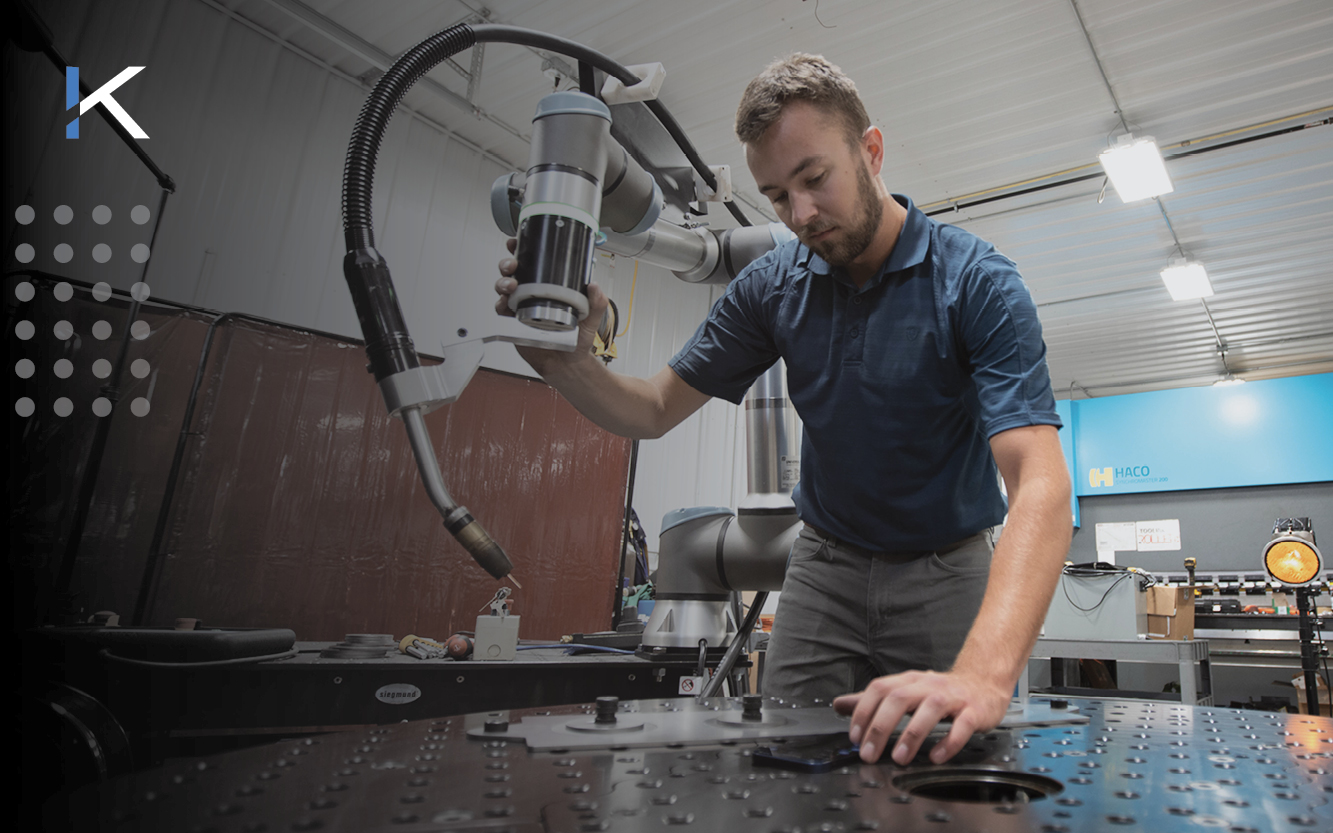Floor space in a shop is like prime real estate in the heart of a city: incredibly valuable and always in short supply.
If you’re managing a small or medium-sized manufacturing operation, you might think that stepping into automated welding means sacrificing a big chunk of your already tight space.
But, what if there was a way to harness the benefits of automation, boost your throughput, and still keep your shop floor space optimized?
Positioners are the answer.
Traditional welding robots require additional components like fencing to be able to operate safely. Cobots paired with positioners can operate within the footprint of a manual welding cell, which makes them a solution for tight spaces.
In this article
• The Space Dilemma ›
• How Cobots + Welding Positioners Help ›
• Improving Shop Floor Safety ›
• Getting Started with Positioners ›
• Kinetic Technologies Seamless Integration Process ›
• Maximizing Shop Floor Space with Kinetic Technologies ›
• FAQ ›
The Space Dilemma
Many believe that automation solutions, especially for welding, require sprawling machines that eat up valuable floor space.
This perception can be a major roadblock for smaller manufacturers looking to enhance their operations through automation.
As shop floors get busier, it can start to affect productivity, with cluttered spaces and disorganized work areas becoming the norm.
How Shop Floor Space Gets Consumed and Wasted
• Large machinery footprints: Big pieces of equipment can dominate the shop floor, limiting space for other operations.
• Poor layout planning: Inefficient arrangement of machines, workstations, and storage areas can lead to unused or underutilized spaces.
• Clutter and disorganization: Tools, materials, and equipment not stored properly can lead to clutter, reducing available working space.
• Unused equipment: Machines that are rarely used but take up permanent space on the shop floor.
• Improper storage solutions: Using inappropriate storage solutions can lead to inefficient use of vertical space and increase the footprint of storage areas.
• Poor workflow design: Lack of a streamlined workflow can result in unnecessary space being allocated for movement that could be minimized with better planning.
• Redundant processes: Duplicate equipment or processes that could be consolidated to free up space.
How Cobots + Welding Positioners Help
Pairing a cobot with a welding positioner transforms the traditional welding setup into a more compact, flexible, and efficient operation. Here’s a look at how they can significantly reduce your shop floor’s footprint while enhancing efficiency:
• Space-Saving Design: Welding positioners are designed to use vertical space, drastically reducing the footprint needed for welding activities. They position large parts in optimal positions, cutting down the need for multiple setups and minimizing the space required for various welding angles.
• Elimination of Caging: One of the standout benefits of cobots is that they don’t require the traditional caging or separated areas needed for conventional robots. This means they can be integrated into the existing footprint of a manual welding cell, saving precious floor space.
Precision and Flexibility
Welding positioners, especially when combined with cobots, offer unmatched precision and flexibility. This duo caters perfectly to the demands of high-mix, low-volume production.
Welding positioners change the way we think about automating welding tasks. Manual time-intensive operations can now be automated, significantly accelerating production rates.
This efficiency doesn’t just mean faster output; it also means enhancing the safety and consistency of your welding processes.
The flexibility of welding positioners, paired with the adaptability of cobots, allows for quick adjustments to different projects. This adaptability eliminates the need to overhaul your shop floor layout with every new task.
Every cobot needs a positioner to truly excel, especially when it comes to handling complex and large parts.
Improving Shop Floor Safety
Welding cobots with positioners aren’t just about improving efficiency; they’re an upgrade for safety on the shop floor.
By automating the movement and handling of materials, positioners significantly reduce the need for manual labor, minimizing the risk of workplace injuries.
Here’s a closer look at the safety benefits:
• Minimized physical strain: Automating tasks with positioners cuts down on the physical demands placed on workers, reducing the incidence of musculoskeletal injuries.
• Integrated safety features: Our positioners stand out as essential safety components within any production setup, designed to improve operational efficiency and maximize uptime. Equipped with robust and adaptable features, our positioners include comprehensive, built-in safety elements.
• Secure workpiece handling: With stable and precise positioning, the risks associated with shifting or unstable materials during welding operations are greatly reduced.
Getting Started with Positioners
Integrating welding positioners into your workflow isn’t just about buying new equipment; it’s about understanding what your shop floor needs and how you can make things run smoother and more efficiently.
• Assess your situation: Take a good look at what’s happening in your shop right now.
– What kind of jobs are you tackling on a daily basis, and where do you feel the pinch?
– Is it spaced?
– Is it the speed of your production? Maybe it’s both.
This step is all about getting a clear picture of your current setup and figuring out where you want to see improvements.
• Imagine the fit: Now that you’ve got a handle on your needs, think about how a welding positioner could fit into your automated processes.
– Imagine how it will change the flow of work.
– How will it interact with the other parts of your production line?
– How will it make things better?

Kinetic Technologies Seamless Integration Process
Kinetic Technologies prides itself on being a solutions-first company, capable of managing your project from inception to the crucial final mile—a step where many of our competitors fall short. Our approach to seamless integration ensures that every aspect of your project is handled with precision and care. Here’s how we do it:
1. Best-in-class robotic components: We start by selecting top-tier robotic components, ensuring the foundation of your solution is built on reliable and high-performance parts.
2. Application-specific design and engineering: Our team provides specialized design and engineering services to tailor every solution to the needs of your application.
3. Customized positioning products: Our positioning products are customized for your unique requirements to improve efficiency and productivity within your operations.
4. Custom manufactured fixtures and tooling: We go beyond off-the-shelf solutions by creating custom fixtures and tooling, designed to perfectly fit your specific project needs.
5. Onsite installation and training: Our service extends to onsite installation and training. We make sure your team is well-equipped to use the new system to its fullest potential.
Maximizing Shop Floor Space with Kinetic Technologies
Partnering with us will change how you approach integrating cobots and welding positioners into your operation. By letting us know your goals, the specific nature of your work, and the layout of your space, we can give you expert solutions perfectly tailored to meet your needs.
We are here to guide you in selecting the setup that will enhance the efficiency and productivity of your shop floor. Get ready to see your manufacturing activities from a new perspective!
FAQs
Can welding positioners be integrated into existing workflows without major disruptions?
Absolutely. Welding positioners can be seamlessly integrated into most existing workflows with minimal disruption. Their design is intended to complement your current operations, improving productivity without the need for significant changes to your layout. Plus, the ease of integration means you can quickly reap the benefits of added efficiency and space optimization.
Are welding positioners flexible enough to handle different types of welding jobs?
Yes, welding positioners are incredibly versatile and can accommodate a wide range of welding tasks. Whether you’re dealing with large, complex parts or smaller components, positioners can be adjusted to suit various sizes and shapes, making them a flexible solution for many welding challenges.
How long before I can expect to see a return on investment (ROI) after integrating a welding positioner?
Many shop owners report seeing immediate improvements in productivity and efficiency upon integrating a welding positioner, leading to a faster ROI. The specific timeline will depend on factors like the volume of your welding operations and the efficiency gains you achieve, but the boost in productivity often results in a noticeable ROI in a short period.





